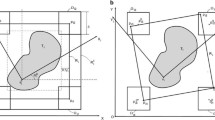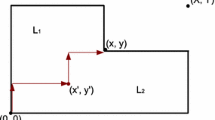Abstract
Different grids of points to solve cutting and packing problems with rectangular shaped items are discussed in this work. The grids are the canonical dissections (also known as normal patterns), useful numbers, reduced raster points, regular normal patterns, and meet-in-the-middle patterns. Theoretical results involving the size and subset relations among the grids are proposed, besides practical procedures to reduce the size. Computational experiments are performed in which the two-dimensional (2D) knapsack problem is solved with an integer linear programming model. The results show the impact on the grids before and after applying the reduction procedures, concluding that the reduced raster points and meet-in-the-middle patterns are generally the grids with the smallest number of points.










Similar content being viewed by others
References
Alvarez-Valdes R, Parreño F, Tamarit JM (2005) A branch-and-cut algorithm for the pallet loading problem. Comput Oper Res 32(11):3007–3029
Alvarez-Valdes R, Parreño F, Tamarit JM (2009) A branch and bound algorithm for the strip packing problem. OR Spectr 31:431–459
Alves C, Brás P, de Carvalho JV, Pinto T (2012) New constructive algorithms for leather nesting in the automotive industry. Comput Oper Res 39(7):1487–1505
Arahori Y, Imamichi T, Nagamochi H (2012) An exact strip packing algorithm based on canonical forms. Comput Oper Res 39(12):2991–3011
Baldacci R, Boschetti MA (2007) A cutting-plane approach for the two-dimensional orthogonal non-guillotine cutting problem. Eur J Oper Res 183:1136–1149
Baldi MM, Perboli G, Tadei R (2012) The three-dimensional knapsack problem with balancing constraints. Appl Math Comput 218(19):9802–9818
Beasley JE (1985a) Algorithms for unconstrained two-dimensional guillotine cutting. J Oper Res Soc 36(4):297–306
Beasley JE (1985b) An exact two-dimensional non-guillotine cutting tree search procedure. Oper Res 33:49–64
Birgin EG, Lobato RD, Morabito R (2010) An effective recursive partitioning approach for the packing of identical rectangles in a rectangle. J Oper Res Soc 61(2):306–320
Birgin EG, Lobato RD, Morabito R (2012) Generating unconstrained two-dimensional non-guillotine cutting patterns by a recursive partitioning algorithm. J Oper Res Soc 63(2):183–200
Boschetti MA, Montaletti L (2010) An exact algorithm for the two-dimensional strip-packing problem. Oper Res 58(6):1774–1791
Boschetti MA, Mingozzi A, Hadjiconstantinou E (2002) New upper bounds for the two-dimensional orthogonal non-guillotine cutting stock problem. IMA J Manag Math 13(2):95–119
Caprara A (2004) Knapsack problems: a book review. 4OR 2(4):317–320
Caprara A, Monaci M (2004) On the two-dimensional knapsack problem. Oper Res Lett 32:5–14
Carnieri C, Mendoza GA, Gavinho LG (1994) Solution procedures for cutting lumber into furniture parts. Eur J Oper Res 73(3):495–501
Christofides N, Whitlock C (1977) An algorithm for two-dimensional cutting problems. Oper Res 25(1):30–44
Cintra GF, Miyazawa FK, Wakabayashi Y, Xavier EC (2008) Algorithms for two-dimensional cutting stock and strip packing problems using dynamic programming and column generation. Eur J Oper Res 191:59–83
Côté JF, Iori M (2018) The meet-in-the-middle principle for cutting and packing problems. INFORMS J Comput 30(4):646–661
Côté JF, Dell’Amico M, Iori M (2014a) Combinatorial benders’ cuts for the strip packing problem. Oper Res 62(3):643–661
Côté JF, Gendreau M, Potvin JY (2014b) An exact algorithm for the two-dimensional orthogonal packing problem with unloading constraints. Oper Res 62(5):1126–1141
Crainic TG, Perboli G, Tadei R (2008) Extreme point-based heuristics for three-dimensional bin packing. Informs J Comput 20(3):368–384
de Almeida A, Figueiredo MB (2010) A particular approach for the three-dimensional packing problem with additional constraints. Comput Oper Res 37(11):1968–1976
Fayard D, Zissimopoulos V (1995) An approximation algorithm for solving unconstrained two-dimensional knapsack problems. Eur J Oper Res 84(3):618–632
Garey MR, Johnson DS (1979) Comput intractability: a guide to the theory of np-completeness. Freeman, San Francisco
Gonçalves RF, Queiroz TA (2014) The knapsack problem with three practical constraints. Procedia Comput Sci 29:2192–2200
Herz JC (1972) Recursive computational procedure for two-dimensional stock cutting. IBM J Res Dev 16(5):462–469
Junqueira L, Morabito R, Yamashita DS (2012) Three-dimensional container loading models with cargo stability and load bearing constraints. Comput Oper Res 39(1):74–85
Leung SCH, Zhang D, Zhou C, Wu T (2012) A hybrid simulated annealing metaheuristic algorithm for the two-dimensional knapsack packing problem. Comput Oper Res 39(1):64–73
Lins L, Lins S, Morabito R (2003) An L-approach for packing (l, w)-rectangles into rectangular and L-shaped pieces. J Oper Res Soc 54(7):777–789
Martello S, Toth P (1990) Knapsack problems: algorithms and computer implementations. Wiley, Chichester
Martello S, Pisinger D, Vigo D (2000) The three-dimensional bin packing problem. Oper Res 48(2):256–267
Martello S, Monaci M, Vigo D (2003) An exact approach to the strip-packing problem. INFORMS J Compu 15(3):310–319
Martinovic J, Hähnel M, Scheithauer G, Dargie W, Fischer A (2018) Cutting stock problems with nondeterministic item lengths: a new approach to server consolidation. 4OR 17(2):173–200
Morabito R, Arenales M (1994) An and/or-graph approach to the container loading problem. Int Trans Oper Res 1(1):59–73
Queiroz TA, Miyazawa FK, Wakabayashi Y, Xavier EC (2012) Algorithms for 3D guillotine cutting problems: unbounded knapsack, cutting stock and strip packing. Comput Oper Res 39(2):200–212
Queiroz TA, Miyazawa FK, Wakabayashi Y (2015) On the L-approach for generating unconstrained two-dimensional non-guillotine cutting patterns. 4OR 13(2):199–219
Queiroz TA, Hokama PHDB, Schouery RCS, Miyazawa FK (2017) Two-dimensional disjunctively constrained knapsack problem: heuristic and exact approaches. Comput Ind Eng 105:313–328
Scheithauer G, Terno J (1996) The G4-heuristic for the pallet loading problem. J Oper Res Soc 47(4):511–522
Terno J, Lindemann R, Scheithauer G (1987) Zuschnittprobleme and ihre praktische lösung. Technical report, Verlag Harry Deutsch, Thun und FrankfurtMain
Valle AMD, Queiroz TA, Miyazawa FK, Xavier EC (2012) Heuristics for two-dimensional knapsack and cutting stock problems with items of irregular shape. Expert Syst Appl 39(16):12,589–12,598
Wäscher G, Haußner H, Schumann H (2007) An improved typology of cutting and packing problems. Eur J Oper Res 183(3):1109–1130
Acknowledgements
This work was supported by the National Counsel of Technological and Scientific Development (CNPq Grant Number 308312/2016-3) and the State of Goiás Research Foundation (FAPEG).
Author information
Authors and Affiliations
Corresponding author
Ethics declarations
Conflict of interest
There is no conflict of interest that may concern the authors.
Human and animal rights
This work does not involve Human Participants and/or Animals.
Additional information
Publisher's Note
Springer Nature remains neutral with regard to jurisdictional claims in published maps and institutional affiliations.
Rights and permissions
About this article
Cite this article
de Almeida Cunha, J.G., de Lima, V.L. & de Queiroz, T.A. Grids for cutting and packing problems: a study in the 2D knapsack problem. 4OR-Q J Oper Res 18, 293–339 (2020). https://doi.org/10.1007/s10288-019-00419-9
Received:
Revised:
Published:
Issue Date:
DOI: https://doi.org/10.1007/s10288-019-00419-9
Keywords
- Grid of points
- Reduction procedures
- Canonical dissections
- Reduced raster points
- Meet-in-the-middle patterns
- Two-dimensional knapsack problem




